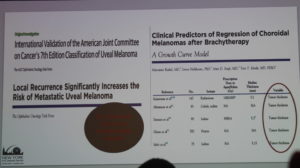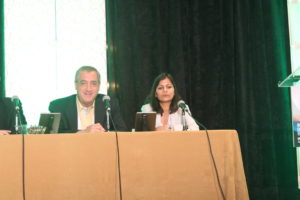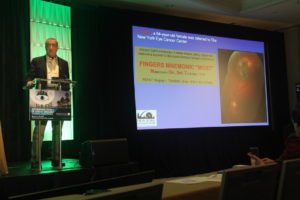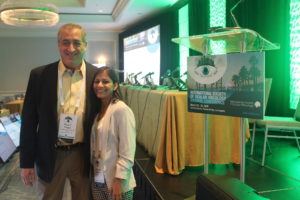Day 2: Live From the ISOO 2019!
Day 2 at the ISOO: Melanoma Day
Every two years, eye cancer specialists worldwide convene at the International Society of Ocular Oncology Conference in order to review latest research and encourage international collaboration within the field of ophthalmic oncology.
For details on the ISOO Biennial Conference, read more here.
How Can You Tell a Choroidal Melanoma is Regressing?


Dr. Abhilasha Maheshwari was the first Eye Cancer Foundation fellow to lecture today with her presentation on the paper Regression Patterns of Choroidal Melanoma after Plaque Brachytherapy, published alongside Dr. Paul T. Finger. In the two-minute rapid-fire session, Dr. Maheshwari filled us in on her data points from the study, concluding that there are various markers that show us when a choroidal melanoma is controlled after treatment with plaque brachytherapy. She provided us various markers, such as:
-

Dr. Finger and Dr. Maheshwari Increased tumor pigmentation.
- Ultrasonography results:
- maintenance of dome/mushroom shape
- decreased tumor thickness
- increased internal reflectivity
- Fundus autofluorescence imaging showed a pattern of increased followed by decreased organge pigment lipofuscin
- OCT showed decreased exudative subretinal fluid, and resolved drusenoid retinal pigment epithelial detachments (DRPED)
- Flurocein angiography showed resolution of intrinsic tumor vascularity
Each of these characteristics serve as indicators of tumor regression. Dr. Maheshwari gave us one final take-away message: better initial local control means extremely less systemic spread, which overall means better patient outcomes.

Interesting New Finding: One talk updated us on recent clinical trials for a drug that showed promise in laboratory studies for reversal of the effect of BAP1-related tumor progression. Perhaps we will hear more on this at the next ISOO!
Unique Case Report: Two, Simultaneous Primary Melanomas
Dr. Maheshwari returned for her second talk of the day, presenting results from Bilateral Simultaneous Primary Choroidal Melanomas: Treated with Palladium-103 Plaque Radiation, published along with Dr. Paul Finger. She elaborated on an interesting case who presented with separate, unrelated choroidal melanomas, one in each eye. After sequential treatment to maximize outcomes, the patient remains at 20/25 vision and shows great outcomes since their latest follow-up.
Unique Case Report: 7 Years After Treatment of a Primary Melanoma, A Second Primary is Found
Dr. Finger gave his first talk of the event to present a unique case of a patient who had been successfully treated for a stage T1 ocular melanoma. Seven years after treatment, however, she developed choroidal metastasis (this one, T3). Following intensive immunotherapy, the patient showed tumor controlled and marked decrease in liver metastasis. Upon follow-up, the patient still sees 20/25 and is maintained with anti-VEGF therapy.
With this talk, Dr. Finger wants to emphasize “the importance of consistent, long-term, post-treatment periodic ophthalmic and systemic surveillance for patients with choroidal melanoma.”

Identifying Genes Associated with Cancer Predisposition
Dr. Colleen Cebulla presented interesting findings in her presentation, Whole exome sequencing to identify candidate genes associated with hereditary predisposition to uveal melanoma. She covered various, possibly cancer-related genes other than the well-known, BAP1 mutation. At the beginning stages of research, the project has already analyzed 29 cases and identified a significantly large incidence of the genes SMARCE1,, PALB2, and MLH1. Particularly of interest are PALB2, which has already been linked to breast, ovarian, and pancreatic cancer risk, and MLH1, which has been linked to Lynch syndrome and has been deemed responsible for multitudes of different tumors.
Dr. Cebulla is happy to welcome additions to the study and to be contacted if any centers are willing!
“SORTT” for Short: Study of Ophthalmic Radiation Therapy Toxicity
Unfortunately unable to attend, Dr. Wolfgang Sauerwein requested Dr. Finger to present on Study of Ophthalmic Radiation Therapy Toxicity (SORTT): a prospective international survey. A major talk of the day, SORTT proposes “a prospective, multicenter, international data registry that collects structured information on toxicities after radiotherapy for eye cancer. This will offer the medical evidence needed for ophthalmic radiation side effect staging and modality selection.” This data may also help to create an AI to help physicians select the optimal radiation modality for each individual case.
Another jam-packed session of presentations, lectures, research findings, and plans for greater multicenter cooperation. As Day 2 comes to a close, Day 3 promises more on melanoma, other intraocular cancers, and the beginning of retinoblastoma discussions.










